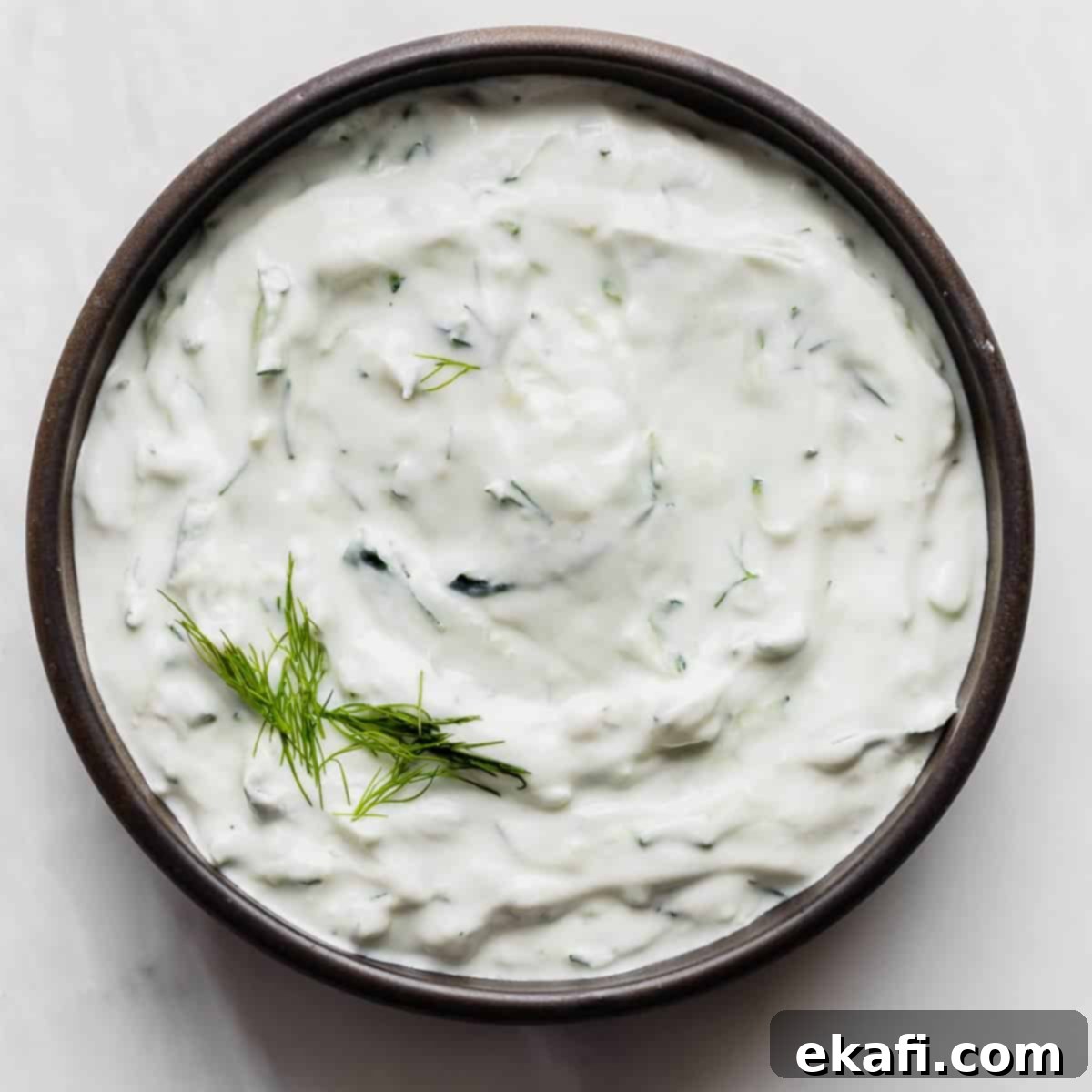Authentic Homemade Tzatziki Recipe: Your Guide to the Best Creamy Greek Cucumber Yogurt Dip
Welcome to the ultimate guide for crafting the most authentic homemade Tzatziki you’ll ever taste! This classic Greek sauce, renowned for its incredibly creamy texture and wonderfully refreshing flavor, is surprisingly simple to make from scratch. Our recipe features the freshest ingredients: cool, crisp grated cucumbers, fragrant fresh dill, and rich plain Greek yogurt, all brought together with a touch of garlic and olive oil. The result is a symphony of Mediterranean flavors that will transport your palate straight to sun-drenched Greek islands. Far from being just a simple condiment for gyros, this versatile cucumber yogurt dip opens up a world of culinary possibilities, enhancing everything from grilled meats and seafood to vibrant fresh vegetables and savory wraps.
While Tzatziki is famously paired with savory Greek dishes like our juicy Greek Chicken Gyros, succulent Lamb Gyros, and flavorful vegetarian Chickpea Gyros, its uses extend far beyond. Imagine dipping crisp fresh vegetables like cool cucumbers, crunchy carrots, or refreshing celery into its cool embrace, or scooping up its creamy goodness with warm, fluffy pita bread and crunchy pita chips. It’s also an excellent complement to crispy falafel, transforming it into a more complete and satisfying meal, and works beautifully as a tangy spread in wraps, sandwiches, or even on your favorite burgers. Prepare to discover the incredible range and delightful versatility of this beloved Greek staple!
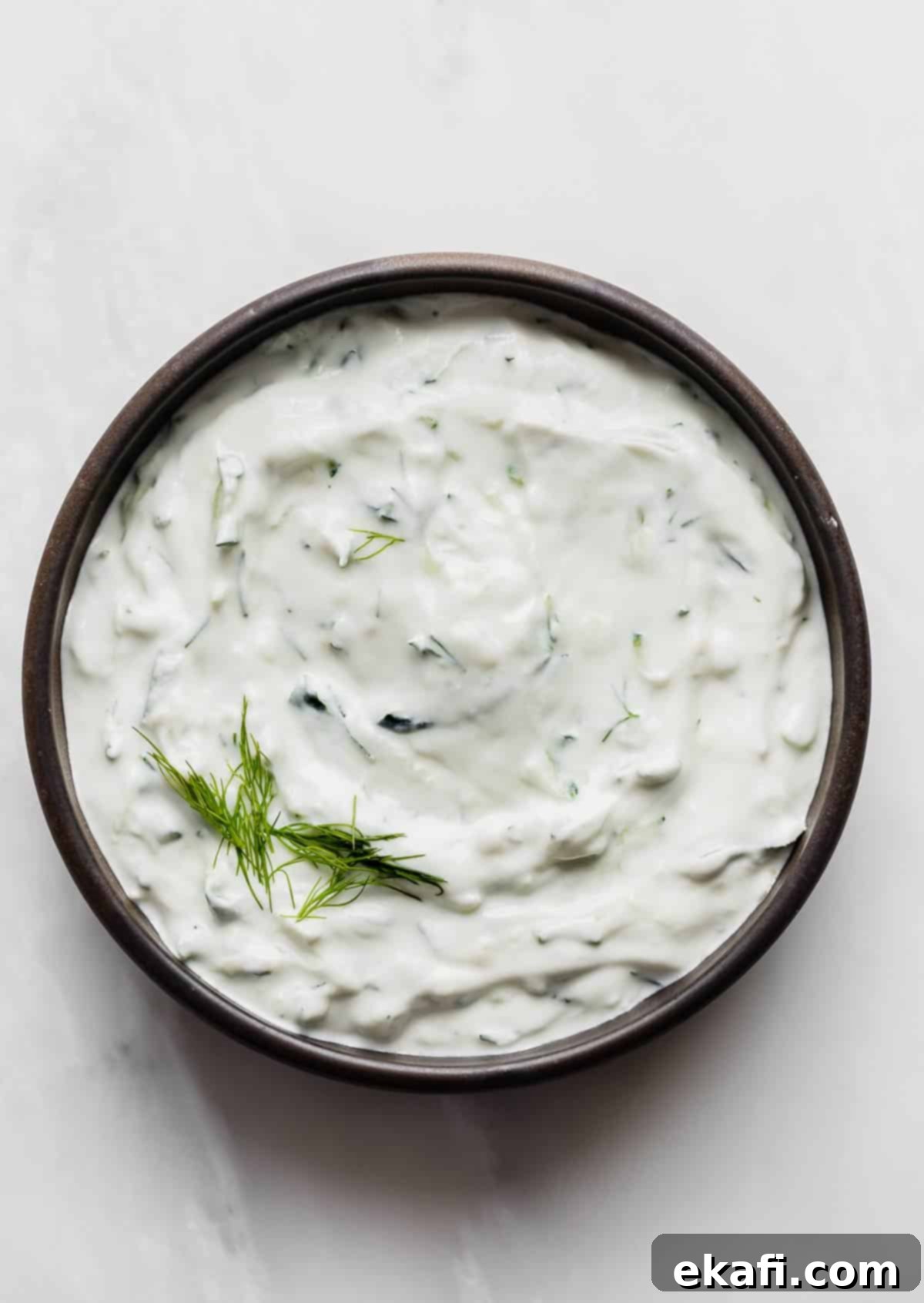
Why This Homemade Tzatziki Recipe Stands Out
- Truly Authentic Greek Flavors. While you don’t need a passport to taste true Greek cuisine, this Tzatziki recipe captures the very essence of traditional Greek flavors. Our carefully balanced method focuses on combining the fresh, tangy notes of thick Greek yogurt and crisp cucumber with aromatic dill and pungent garlic. The result is a creamy sauce that’s rich, wonderfully refreshing, and perfectly balanced, evoking the authentic taste of sun-drenched Mediterranean islands with every bite.
- Undeniably the Best Tzatziki You’ll Ever Make. Forget bland, store-bought versions or even many restaurant offerings. This recipe yields a Tzatziki that is genuinely superior in both flavor and texture. The secret lies in using high-quality, fresh ingredients and a simple, time-tested technique that brings out the best in each component. You’ll achieve the perfect balance of tanginess, an irresistible creamy consistency, and herbaceous freshness, making it a truly unforgettable and satisfying condiment that you’ll want to make again and again.
- Incredibly Versatile for Endless Culinary Creations. Beyond its classic role as a cooling accompaniment to gyros, this homemade cucumber yogurt sauce is a culinary chameleon. Use it generously as a vibrant, light salad dressing to elevate your greens, slather it inside wraps or sandwiches for a burst of refreshing flavor, or serve it alongside grilled chicken, lamb, or fish. It also shines as a healthy, flavorful dip for a colorful array of fresh vegetables, crispy pita bread, or even as a unique, creamy topping for baked potatoes or eggs. Its remarkable adaptability makes it an essential and beloved staple in any kitchen.
Essential Ingredient Notes for Perfect Tzatziki
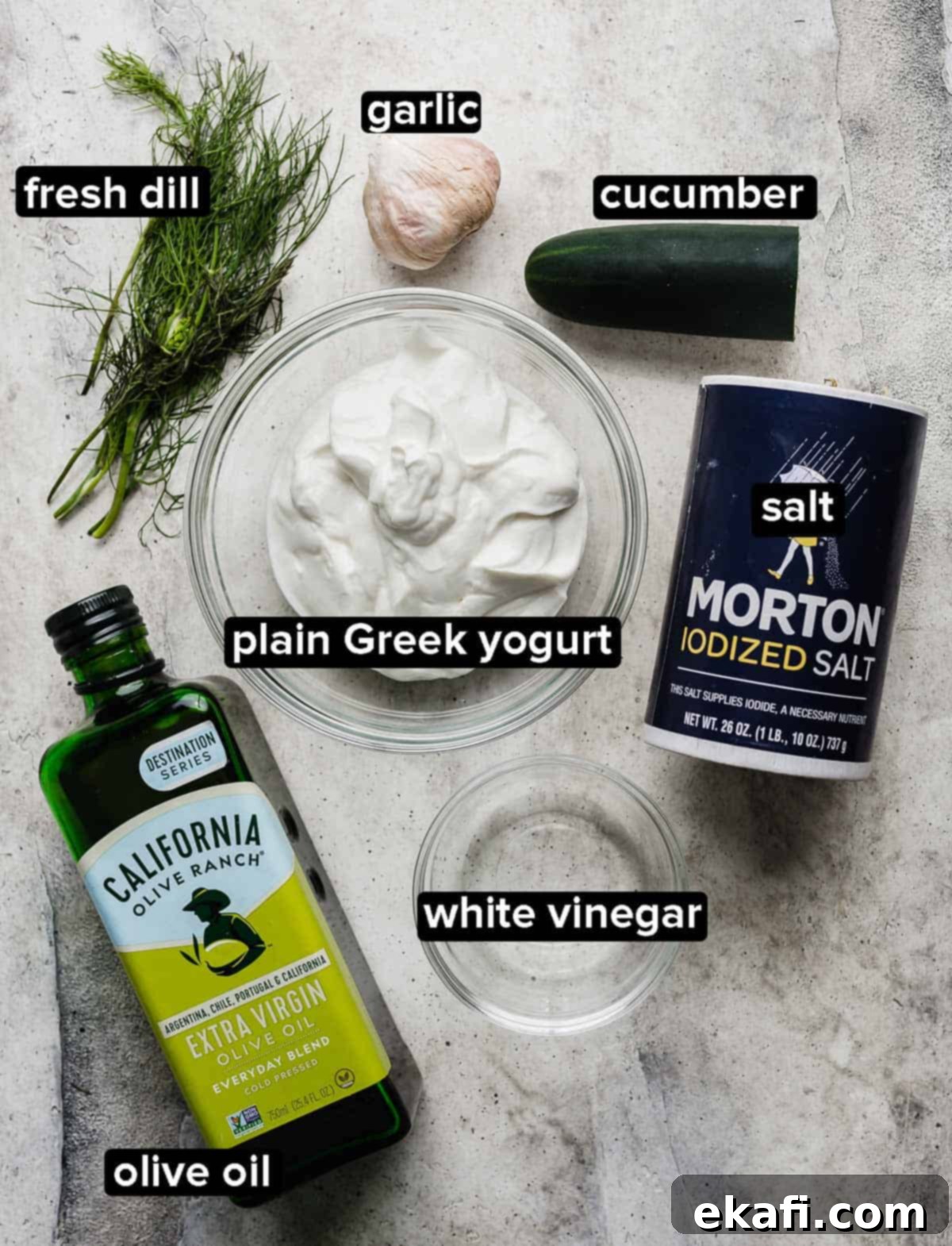
- Plain Greek Yogurt: The foundation of any great Tzatziki is thick, creamy Greek yogurt. While you can opt for low-fat or even non-fat varieties for a lighter version, we highly recommend using full-fat plain Greek yogurt. Its richer texture and deeper flavor provide an unparalleled creaminess that truly elevates the sauce. The inherent thickness of Greek yogurt is crucial for a perfectly structured Tzatziki; regular yogurt is typically too thin and will result in a watery consistency, so always choose a good quality Greek brand. For those exploring dairy-free alternatives, a thick, unsweetened coconut or almond-based yogurt could be used, though this will slightly alter the classic flavor profile.
- Extra Virgin Olive Oil: High-quality extra virgin olive oil is more than just a liquid in this recipe; it’s a key flavor enhancer. It adds a subtle richness, a hint of fruitiness, and a smooth mouthfeel that complements the tanginess of the yogurt and the freshness of the cucumber. Choose a good quality olive oil for the best results, as its flavor will shine through in the final sauce.
- Vinegar: In this authentic Tzatziki recipe, we prefer white vinegar over fresh lemon juice. While lemon juice is often used, we find that its strong acidity can sometimes overpower the delicate flavors of the cucumber and dill. White vinegar, on the other hand, provides a clean, bright tang without competing for attention, allowing the other fresh ingredients to truly sing. You can also experiment with red wine vinegar for a slightly different depth of flavor.
- Fresh Dill: Fresh herbs are a game-changer in Tzatziki, and fresh dill is non-negotiable for that classic, vibrant taste. Its distinct, slightly anise-like flavor is essential for authenticity. If fresh dill isn’t available, dried dill can be used in a pinch, but remember that fresh herbs offer a much stronger and more aromatic flavor. As a variation, some Greek recipes also incorporate a touch of fresh mint, which adds another layer of refreshing complexity.
- Fresh Cucumber: The cool crunch of fresh cucumber is vital for Tzatziki. Be sure to fully wash your cucumber before grating it. You can absolutely leave the skin on for added color, texture, and nutrients, especially if using English cucumbers which have thinner skins. Regular cucumbers work just as well, but you might consider peeling them if their skin is particularly thick or waxy, and often deseding them will help reduce excess moisture, though thorough squeezing (as outlined in the steps) is the most important step.
- Garlic Cloves: Freshly minced garlic adds that characteristic pungent depth and aromatic kick to the Tzatziki. The amount can be adjusted to your preference, but a couple of cloves provide the perfect balance without overpowering the other ingredients.
- Salt: Essential for seasoning and enhancing all the other flavors. It also helps draw out excess moisture from the cucumber.
Easy Step-by-Step Instructions for Homemade Tzatziki
- Prepare the Yogurt Base (and let flavors meld). In a medium-sized mixing bowl, combine the 1 1/2 cups of plain Greek yogurt, 2 tablespoons of extra virgin olive oil, 1 tablespoon of white vinegar, the minced garlic cloves, and 1/2 teaspoon of salt. Stir all these ingredients together thoroughly until well combined and smooth. For the absolute best flavor, cover the bowl and refrigerate the mixture overnight. This crucial step allows the garlic, dill (which will be added later), and yogurt to truly meld and deepen in flavor, resulting in a more complex and harmonious Tzatziki. However, if you’re short on time, you can proceed to the next steps immediately.
- Crucial Step: Remove Excess Water from Cucumbers. This is perhaps the most important step for achieving a thick, creamy Tzatziki and preventing a watery sauce. Take your grated cucumber and place it in several layers of strong paper towels or, even better, a clean cheesecloth or thin kitchen towel. Gather the edges and twist tightly, wringing out as much excess liquid as possible over the sink. You’ll be surprised how much water comes out! Continue squeezing until the cucumber feels relatively dry. This step ensures your Tzatziki maintains its desirable thick consistency.
- Combine and Serve Chilled. Once the cucumber is thoroughly drained, add it along with 1 tablespoon of fresh, chopped dill to your prepared yogurt mixture. Stir gently to combine all the ingredients evenly. Give it a taste and adjust seasoning if necessary, adding more salt or a tiny splash more vinegar if desired. For the freshest and most authentic experience, serve this delicious cucumber sauce chilled. A sprinkle of fresh dill and a drizzle of olive oil before serving make for a beautiful presentation.
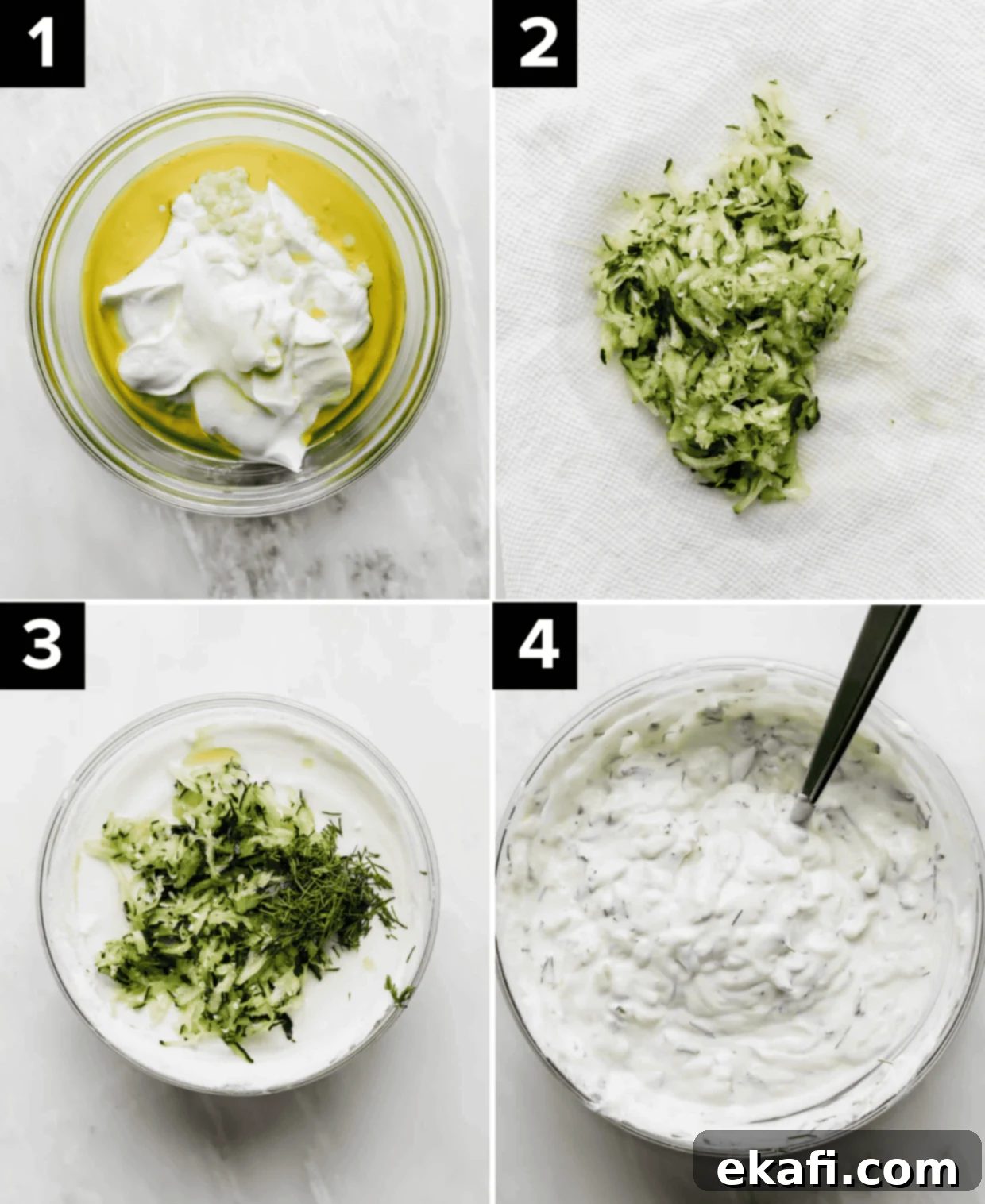
Expert Tips for the Best Homemade Tzatziki
Optimize Flavor with Overnight Chilling: While this Tzatziki is delicious made fresh, letting the yogurt mixture (before adding cucumber and dill) sit in the fridge overnight will work wonders for the flavor. This allows the garlic, olive oil, and vinegar to infuse deeply into the yogurt, creating a more complex and harmonious base. The wait is worth it for an unparalleled taste experience.
Grating Cucumbers for Texture: A standard box grater is your best friend for preparing the cucumbers. Use the coarse side to get nice, uniform shreds. If you prefer a finer texture, you can use the finer side, but ensure you squeeze out even more liquid. Alternatively, a food processor with a grating attachment can make quick work of this step, especially if you’re making a larger batch.
Healthy and Delicious Dip: Tzatziki is an excellent choice if you’re looking for a healthier dipping sauce or spread. Made with protein-rich Greek yogurt and fresh vegetables, it’s naturally lower in calories and fat compared to many creamy dips, especially if you choose a low-fat or non-fat Greek yogurt. It’s a fantastic way to enjoy fresh veggies or add a flavorful, guilt-free element to your meals.
Choosing the Right Cucumber: Both regular garden cucumbers and English cucumbers work well for Tzatziki. English cucumbers (also known as hothouse or seedless cucumbers) typically have fewer and smaller seeds and thinner skins, which means they tend to be less bitter and require less preparation (no need to deseed). If using regular cucumbers, you might consider removing some of the larger seeds for a smoother texture and less water content, though thoroughly squeezing out moisture remains the most important step for both types.
Preventing a Watery Tzatziki: The most common issue with homemade Tzatziki is a runny consistency. This almost always comes down to insufficient draining of the cucumber. After grating, ensure you squeeze out every last drop of excess liquid. Using a clean kitchen towel or cheesecloth allows for a much more effective squeeze than paper towels. If you still find your dip too runny, try deseding the cucumber next time before grating, or allow the finished Tzatziki to sit in a fine-mesh sieve over a bowl in the fridge for an hour or two to let any remaining liquid drain off.
Adjusting Seasoning: Always taste your Tzatziki before serving. The salt content can vary based on the yogurt and your personal preference. Add more salt, a touch more vinegar, or even a tiny squeeze of lemon juice if you feel it needs a brighter kick. Freshly ground black pepper can also add a nice subtle spice.
Make Ahead, Storing, and Freezing Your Tzatziki
Make Ahead: This homemade Tzatziki sauce is fantastic for meal prep! You can easily prepare the recipe days in advance, allowing the flavors to deepen and meld beautifully in the refrigerator. In fact, making it a day ahead often results in a more flavorful sauce, as the garlic and dill have more time to infuse into the yogurt.
Storing: To maintain its freshness and prevent it from absorbing other odors, store your Greek Tzatziki in an airtight container in the refrigerator. Properly stored, it will keep for 3-4 days. Always give it a good stir before serving, as some separation might occur over time.
Freezing: While technically possible to freeze, it’s generally not recommended for optimal quality. Because Tzatziki is a yogurt-based dip, it may separate and become grainy once frozen and thawed, significantly impacting its creamy texture. Additionally, cucumbers can become quite mushy and lose their crispness after freezing, further affecting the overall consistency and appeal. For the best flavor and texture, enjoy your Tzatziki fresh or within its refrigerated shelf life.
Tzatziki Recipe FAQs
Tzatziki sauce boasts a rich history deeply rooted in Mediterranean and Middle Eastern culinary traditions. It is widely recognized as the Greek adaptation of the Indian raita sauce, evolving and spreading through various cultures during the time of the Ottoman Empire, which was established in the 13th century! This historical connection highlights its journey across different regions, where similar yogurt and cucumber based dips were developed. While most famously associated with Greek cuisine today, you’ll find similar refreshing yogurt sauces in many Mediterranean, Middle Eastern, and even Balkan recipes, each with its unique twist. You can read up more about its fascinating origins from resources like The Traveling Cook Abroad.
Tzatziki sauce is incredibly versatile and pairs beautifully with a vast array of dishes. Its most famous pairing is, of course, with gyros – whether it’s chicken, lamb, or vegetarian falafel gyros. Beyond that, it’s a delightful accompaniment to grilled meats like chicken souvlaki, lamb chops, or beef kebabs, and it complements baked or grilled fish wonderfully. You can also use it as a creamy spread for burgers and sandwiches, adding a fresh, tangy kick. Don’t forget its role as a dip! Serve it with a vibrant platter of fresh vegetables (cucumbers, carrots, bell peppers, cherry tomatoes), crispy pita chips, or warm, soft pita bread. It can even be thinned slightly to create a refreshing salad dressing for Mediterranean-inspired salads.
Absolutely! Tzatziki sauce is widely considered a healthy and nutritious option, especially when made at home with fresh ingredients. Its base of Greek yogurt makes it high in protein and calcium, while the cucumber adds hydration and vitamins. It’s naturally low in fat and calories, particularly if you opt for a low-fat or non-fat Greek yogurt. By making your own, you control the ingredients, avoiding unnecessary additives or excessive sodium often found in store-bought versions. It’s a fantastic way to add flavor and a creamy texture to your meals without compromising on health.
Traditional Tzatziki sauce is made with a yogurt base, which contains dairy. Therefore, the classic recipe is not dairy-free. However, for those with dairy restrictions or who prefer plant-based options, there are many excellent dairy-free Tzatziki sauce recipes available that substitute regular Greek yogurt with thick, unsweetened dairy-free yogurts, such as those made from coconut, almond, or cashew milk. Just ensure your chosen dairy-free yogurt is plain and unsweetened to maintain the savory flavor profile.
Generally, yes, Tzatziki sauce is naturally gluten-free. The core ingredients – Greek yogurt, cucumber, dill, olive oil, garlic, and vinegar – are all typically gluten-free. Most plain Greek yogurts do not contain gluten. However, it’s always a good practice to double-check the ingredient list on the specific Greek yogurt brand you purchase, especially if you have a severe gluten allergy or sensitivity, just to be absolutely sure there are no hidden gluten-containing additives. Better safe than sorry when it comes to dietary restrictions!
A watery Tzatziki sauce is a common issue, and it almost always stems from one crucial step: failing to adequately squeeze the excess water out of your grated cucumbers. Cucumbers have a very high water content, and if that moisture isn’t removed, it will leach into your yogurt base, making the entire sauce thin and runny. Ensure you use several layers of paper towels, or better yet, a clean kitchen towel or cheesecloth, and wring out the grated cucumber with significant force until it feels relatively dry. Another contributing factor could be using regular yogurt instead of thick Greek yogurt, or an overly thin brand of Greek yogurt. Always start with a very thick yogurt base.
While you can technically freeze Tzatziki sauce, it’s generally not recommended for optimal texture and quality. The main ingredients, Greek yogurt and fresh cucumber, do not fare well during the freezing and thawing process. The yogurt base will likely separate and become grainy or curdled, losing its smooth, creamy consistency. Furthermore, the high water content in the cucumbers means they will become mushy and lose their crispness once thawed, affecting the overall mouthfeel of the sauce. For the best culinary experience, it’s always best to enjoy Tzatziki fresh or consume it within its refrigerated shelf life.
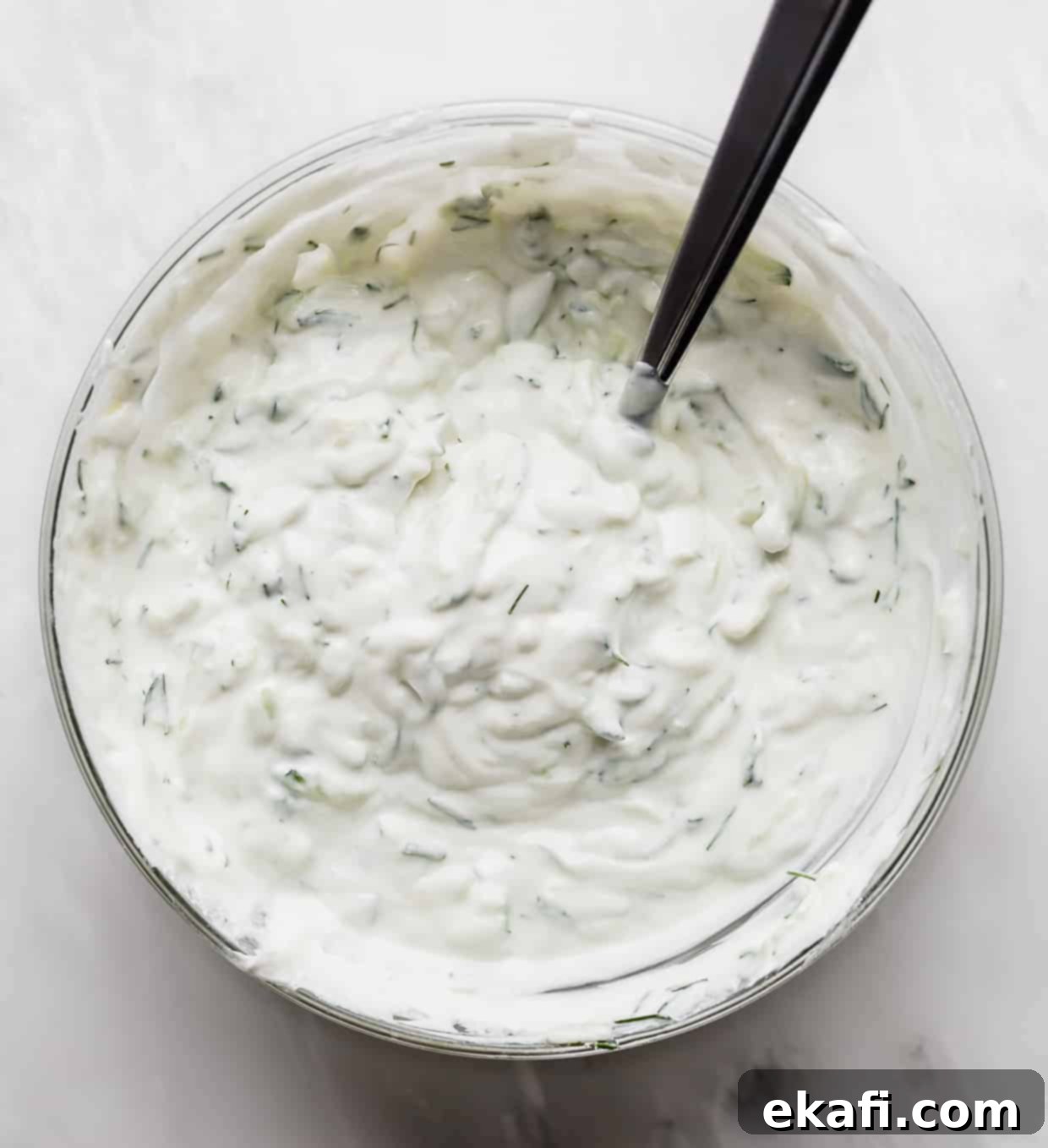
Delicious Recipes to Serve with Your Homemade Tzatziki
- Healthy Chicken Wraps: The creamy, tangy Tzatziki provides a perfect cooling counterpoint to savory chicken and fresh veggies in a wrap.
- Greek Quesadillas: Transform traditional quesadillas with a Mediterranean twist, using Tzatziki as a vibrant, fresh dipping sauce.
- Summer Fresh Greek Pasta Salad: Swirl a dollop of Tzatziki into your pasta salad for an extra layer of creamy, herbaceous flavor and a refreshing touch.
- Lemon Honey Glazed Salmon: The richness of salmon is beautifully balanced by the light, zesty profile of Tzatziki, making it an ideal sauce for seafood.
- Grilled Chicken: Whether it’s Italian-inspired or simply seasoned, a generous serving of Tzatziki adds moisture and a burst of fresh flavor to any grilled chicken dish.
- **Vegetable Platters:** A fresh and healthy dip for a colorful assortment of bell peppers, carrots, celery sticks, and cherry tomatoes.
- **Pita Bread & Chips:** The ultimate dipper for warm, soft pita or crunchy pita chips for a satisfying snack.
Did you make this incredibly delicious recipe? We’d absolutely love to hear about your experience! Please leave a star rating and a review right here on the blog post, or simply scroll below the recipe card to share your thoughts. Your feedback helps us and other home cooks.
Stay up-to-date with all our latest recipes and kitchen adventures by following us on Instagram, TikTok, YouTube, Facebook, and Pinterest. We love seeing your culinary creations!
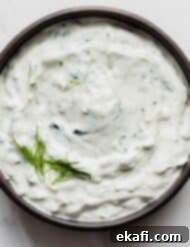
Print
SaveSaved!
Review
Tzatziki Recipe
Ingredients
- 1 1/2 cups plain Greek yogurt
- 2 tablespoons olive oil
- 1 tablespoon white vinegar
- 2 garlic cloves – minced (adjust to taste)
- 1/2 teaspoon salt – or to taste
- 1 tablespoon fresh dill – finely chopped (more if desired)
- 1/2 large cucumber – unpeeled, grated, and thoroughly squeezed to drain all excess liquid (crucial step!)
Equipment
-
Measuring cups
-
Box grater
-
Garlic press/mincer
-
Mixing bowls
-
Paper towels or clean kitchen towel/cheesecloth
Instructions
-
In a medium-sized bowl, stir together the plain Greek yogurt, extra virgin olive oil, white vinegar, minced garlic, and salt until well combined and smooth. Cover the bowl tightly and refrigerate overnight. This allows the flavors to truly meld and deepen, creating a more harmonious and authentic Tzatziki.
-
Before adding to the yogurt mixture, place the grated cucumber between several layers of strong paper towels or a clean kitchen towel/cheesecloth. Gather the edges and squeeze out as much excess liquid as possible over a sink. This is a crucial step to prevent your Tzatziki from becoming watery! Once the cucumber is thoroughly drained, stir it, along with the fresh chopped dill, into the chilled yogurt mixture.
-
Taste and adjust seasoning if needed. Serve your delicious cucumber sauce chilled. It can be made in advance; once prepared, cover and store it in an airtight container in the fridge for 3-4 days.
